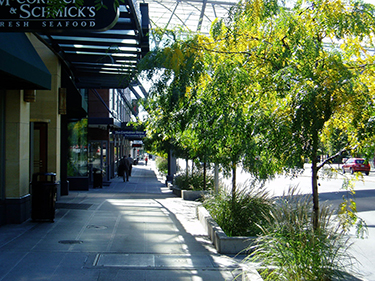|
Subscribe / Renew |
|
|
Contact Us |
|
| ► Subscribe to our Free Weekly Newsletter | |
| home | Welcome, sign in or click here to subscribe. | login |
Construction
| |
 |
March 26, 2015
What can Bellevue learn from other big cities?
Baylis Architects

Brand
|
The city of Bellevue’s rapid transformation from pre-war strawberry fields via 1970s asphalt parking lot to today’s high-tech urban village has been astonishing. Such rapid development brings both great opportunity and potential risk.
As Bellevue continues to head into the future at breakneck speed, what can we do to guide its development and continuing success? How do we ensure that young people attracted to jobs in Bellevue’s thriving high-tech sector choose to stay, live, raise their kids and ultimately retire here? How do we make it affordable?
In 1990, just 1,192 people lived in downtown Bellevue. By 2012 it was 10,500. By 2035 we’re looking at a probable 19,000 people — most of them in an area that represents just 2 percent of the city’s total land area.
That’s a truly dramatic transformation for those former strawberry fields. If we are to avoid a repeat of the characterless asphalt phase of the 1970s this growth will need some guidance.
In 2012, the city and the Bellevue Department of Community Development created the Downtown Livability Initiative. Conrad Lee, mayor at that time, appointed a citizens’ advisory committee (CAC) to shepherd the initiative.

Working with a spectrum of stakeholders and community members, and with active and engaged support from the Bellevue Downtown Association, the CAC has identified critical success factors for Bellevue’s future.
This excerpt from the Downtown Bellevue Subarea Plan defines livability as being:
“…about quality; about weaving an urban fabric rich in resources and quality of life. Livable cities provide welcoming places to eat and sources of entertainment. Livable cities develop parks and open space. Truly great cities are also memorable. Memorable cities impart an unforgettable experience from having visited there. Memorable cities have strong, clear identities.”
With the benefit of hindsight and the opportunity to explore what’s working in other burgeoning cities around the world, the CAC identified the key characteristics that will set downtown Bellevue on the path to sustaining itself as a livable, memorable city.
Livable cities are walkable
First among the CAC’s recommendations is the overriding importance of creating safe, easy and attractive pedestrian access in the downtown area.
Melbourne, Australia, recently voted the world’s “Most Livable City,” is characterized by its wide pedestrian sidewalks bustling with activity and lots of opportunities for socializing or the simple pleasure of people-watching. In Bellevue, where the average block is almost three times longer than a typical Portland or Seattle block, this means finding ways to break the distances with mid-block connectors, wider sidewalks, mid-block street crossings and enhanced pedestrian amenities.
Another challenge is the width of the streets and how much time it takes a pedestrian to cross. The current young demographic of high-tech workers may have no problem with a brisk sprint across four to six lanes of traffic in the allotted 12-second crossing time, but what about parents with toddlers? What happens as we get older and less inclined to jog across intersections? We need to find better, easier ways for pedestrians to safely cross downtown streets.
Open, green space is also an essential feature of walkable cities — one that enhances their appeal but also serves the critical function of providing gathering places that reinforce neighborhood identity, encourage people to linger outdoors and offer recreational opportunities for young and old alike.
Encoding livability
As designers and creators of the built environment we can find many elegant solutions to such challenges, but they require careful planning. The goal of the CAC is to recommend updates to the city land use code, adopted over 30 years ago, that will promote the adoption of livable development strategies as the city continues to evolve.
The recommendations focus on several key areas with consideration to how their development relates to livability:
Major pedestrian corridor
• Extend the pedestrian corridor to the east to be more integrated with the Civic Center District and the future light rail station.
• Create a memorable downtown feature with green, open space, better weather protection and improved wayfinding, lighting and crosswalks.
Open space and amenities
• Identify and incentivize open space for each downtown neighborhood, to help address each neighborhood’s needs and character.
• Strengthen requirements and guidelines for integrating pathways through superblocks.
• Identify and prioritize amenities that reinforce neighborhood identity and encourage creative design.
• Potential to focus bonuses on the most important amenities.
Building height and form
• Encourage more interesting and memorable architecture and create a more distinctive skyline.
• Be flexible enough to allow architects and designers the freedom to create unique buildings.
• Create opportunity for more light and air between buildings by increasing height and allowing more open space at ground level.
• Incentive schemes for additional height or floor space.
• Promote variability in building heights to reinforce district identity.
• Focus density around light rail and transit.
Parking and transportation
Livable cities have comprehensive parking strategies and encourage efficient, multi-modal transportation including cars, transit, bikes, light rail and pedestrian accessibility. The city needs to adopt common-sense, achievable targets that will greatly enhance the livability experience, for residents and workers alike.
In the downtown core these include:
• A comprehensive parking study to assess on-street parking, public garages, and coordinated management of the parking supply such as valet or shared use.
• Review the code to respond to changing needs as East Link light rail nears completion (2021-23).
• Explore a potential shared public parking facility for short-term use to serve the Old Bellevue area to encourage visitors and shopping.
• Reduce single-occupancy-vehicle trips to 40—50 percent of total transportation mix.
• Wider sidewalks with pedestrian amenities.
• Clear, easy to read signage.
Build it and they will come
There is much we can do to inform and construct a framework for successful city development, but the critical success factor is less easy to codify: people.
Truly livable cities evolve organically as a result of people choosing to make them their home. Affordable housing, open space, mobility and access, and good jobs are all factors in this decision but the ingredient that sets truly memorable cities apart is diversity. Think of the kinds of things we want to see when we visit a different city: Graffiti Alley in Melbourne, Covent Garden in London, Granville Island in Vancouver, Chinatown in San Francisco, even the Burj Khalifa in Dubai. We want to see the things we can’t find anywhere else.
This is particularly challenging for a city as young as Bellevue. We already have many attractive amenities including Bellevue Square and The Bellevue Collection, Downtown Park, Meydenbauer Center, Bellevue Arts Museum, and the newly renovated Bellevue Botanical Garden. The list will continue to grow as the city expands Meydenbauer Waterfront Park and plans the future Tateuchi Center performing arts facility.
As we build new and rebuild old we must find the balance between providing the best amenities and risking the loss of the unique offerings that make a city authentic. Branded restaurants and luxury boutiques have appeal, but they must be balanced by the ethnic “hole-in-the-wall” lunch favorite.
We need a place for quirky, small shops filled with objects that catch the eye and slow down the passing pedestrian, encouraging them to linger. We need outdoor spaces with their own identities: some days you want the excitement of the skate park, some days you want the Zen-like peace of a tranquil garden.
Memorable cities have nooks and crannies that offer it all.
As we continue to shape the future of Bellevue these are questions we should all be thinking about. The CAC has laid the foundations for a flexible framework that enshrines many of the common elements of successful cities. It is up to us, developers, designers, engineers of the built environment — people — to add the personal flair and creativity that are the hallmarks of diversity and authenticity.
Brian Brand is a principal at Baylis Architects. He is a long-time resident of the Bellevue area, is a board member and executive committee member of the Bellevue Downtown Association, and a strong advocate for the Downtown Livability Initiative.
Other Stories:
- Bellevue blooms with construction cranes
- Homogeneous? Boring? No way! Why one new millennial loves Bellevue
- Downtown office space will jump 23% in 18 months
- Retail drives growth in once ‘sleepy’ downtown



